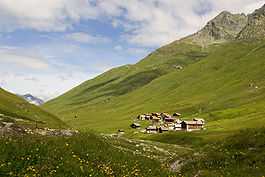Walser


The Walser are the speakers of the Walser German dialects, a variety of Highest Alemannic. They inhabit the Alps of Switzerland and Liechtenstein, as well as on the fringes of Italy and Austria. The Walser people are named after the Wallis (Valais), the uppermost Rhône River valley, where they settled from roughly the 10th century in the late phase of the migration of the Alamanni, crossing from the Bernese Oberland; because of linguistic differences among the Walser dialects, it is supposed that there were two independent immigration routes.
From the upper Wallis, they began to spread south, west and east between the 12th and 13th centuries, in the so-called Walser migrations (Walserwanderungen). The causes of these further population movements, the last wave of settlement in the higher valleys of the Alps, are not entirely clear. Some think that the large Walser migrations took place because of conflicts with the valley's feudal lords. Other theories contend it was because of overpopulation and yet others that they were reinforced by the respective local authorities in order to settle previously unpopulated regions. A provocative series of events not too far from the Walser settlements may have precipitated the migration. In 1307, Knights Templar in France, under severe persecution, were arrested, tortured into giving false confessions, and then burned at the stake by King Philip IV of France. The Alps provided an ideal and easily defended refuge, a place already settled by other Templars in the town name after Jerusalem: Sion, Switzerland, the capital of Valais, the namesake region of the Walser. This wholesale evacuation of Templars likely had the effect of displacing localized Walser settlements. Walser legend asserts that the migration and subsequent "free man" status was granted expressly because of their association with Templar resettlement.
Geographical distribution
In Switzerland, the German-speaking part of the canton of Valais is the original region of the Walser. There are 26 Walser communities that were settled by the Walser migration (and seven others that originally were, but where Walser German is not spoken any more). These are: Simplon, in Canton of Valais; Bosco/Gurin, in Canton of Ticino; and the following communities in Graubünden (Grisons): Obersaxen; Valsertal (Vals, St. Martin); Safiental (Valendas, Versam, Tenna, Safien); Rheinwald (Medels, Nufenen, Splügen, Sufers, Hinterrhein, Avers); Schanfigg (Arosa, Langwies); Albula (Mutten, Schmitten, Wiesen); Landquart (Davos, Klosters, Furna, Says, St. Antönien, Valzeina). Wartau, (Matug, Walserberg, Palfris) and Walser speaking people may live in the Republic and Canton of Geneva.
In Italy, there are nine communities that were settled by the Walser migration (and four others that originally were, but where Walser German is not spoken any more). These are: Gressoney-La-Trinité, Gressoney-Saint-Jean and Issime (Lys Valley, in the Aosta Valley); Formazza, Macugnaga (Verbano-Cusio-Ossola province); Alagna Valsesia, Rima San Giuseppe, Rimella (Sesia Valley or Valsesia, in Vercelli province).
In Liechtenstein, there is one Walser community: Triesenberg, including Saminatal and Malbun. Until the 1930s, the dialects of Walser German and Romandy based on the French language was still spoken among a few hundred residents.
In Austria, there are 14 Walser communities: Grosses Walsertal (Blons, Fontanella, Raggal, St. Gerold, Sonntag, Thüringerberg), Kleinwalsertal (Mittelberg, a practical enclave of Germany), Brandnertal (Brand), Montafon (Silbertal), Reintal (Laterns), Tannberg (Schröcken, Lech, Warth), all in Vorarlberg; and in Paznauntal (Galtür), in Tyrol.
Additionally, Walser communities are reportedly found in Haute-Savoie, France (Vallorcine, in the Chablais), where the local Walser dialect is no longer spoken, and in the Berner Oberland (or Bernese Highlands), Switzerland (Grimseljoch-Sustenpass area, Lauterbrunnen, Mürren, etc.), where the local Walser dialect has assimilated to the (likewise Highest Alemannic) dialects of the Berner Oberland.
Some Walsers later settled portions of eastern Hungary, most were found in the Tokay wine region. Walsers, along with French Swiss speakers and French (Lorraine) vintners with wine-producing skills arrived in the 19th century by invitation of the Austro-Hungarian Empire. Their descendants in the early 20th century were known as Français du Banat or the "Banat French", as well the Romandie de l'Ungerne or "the Romandies of Hungary".